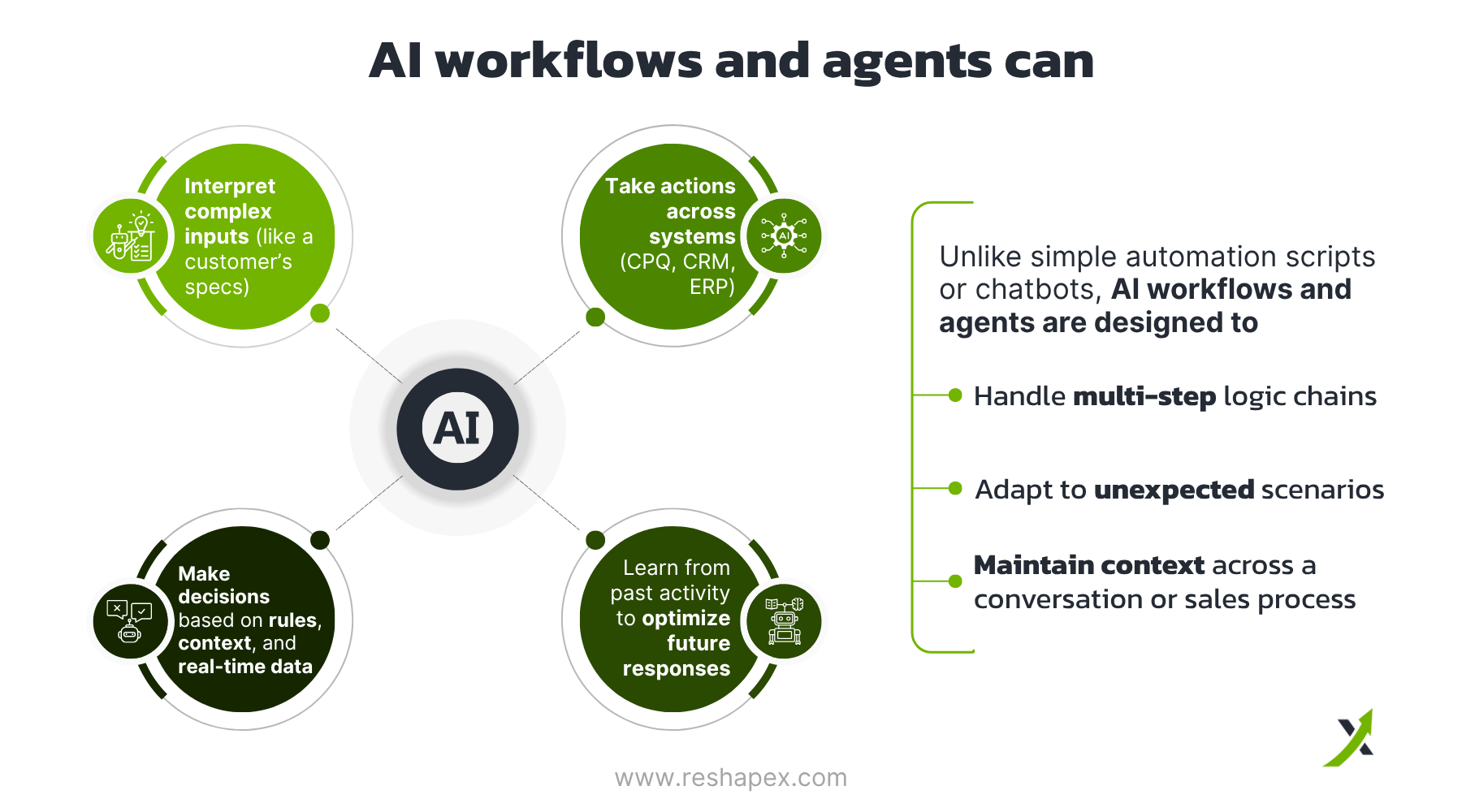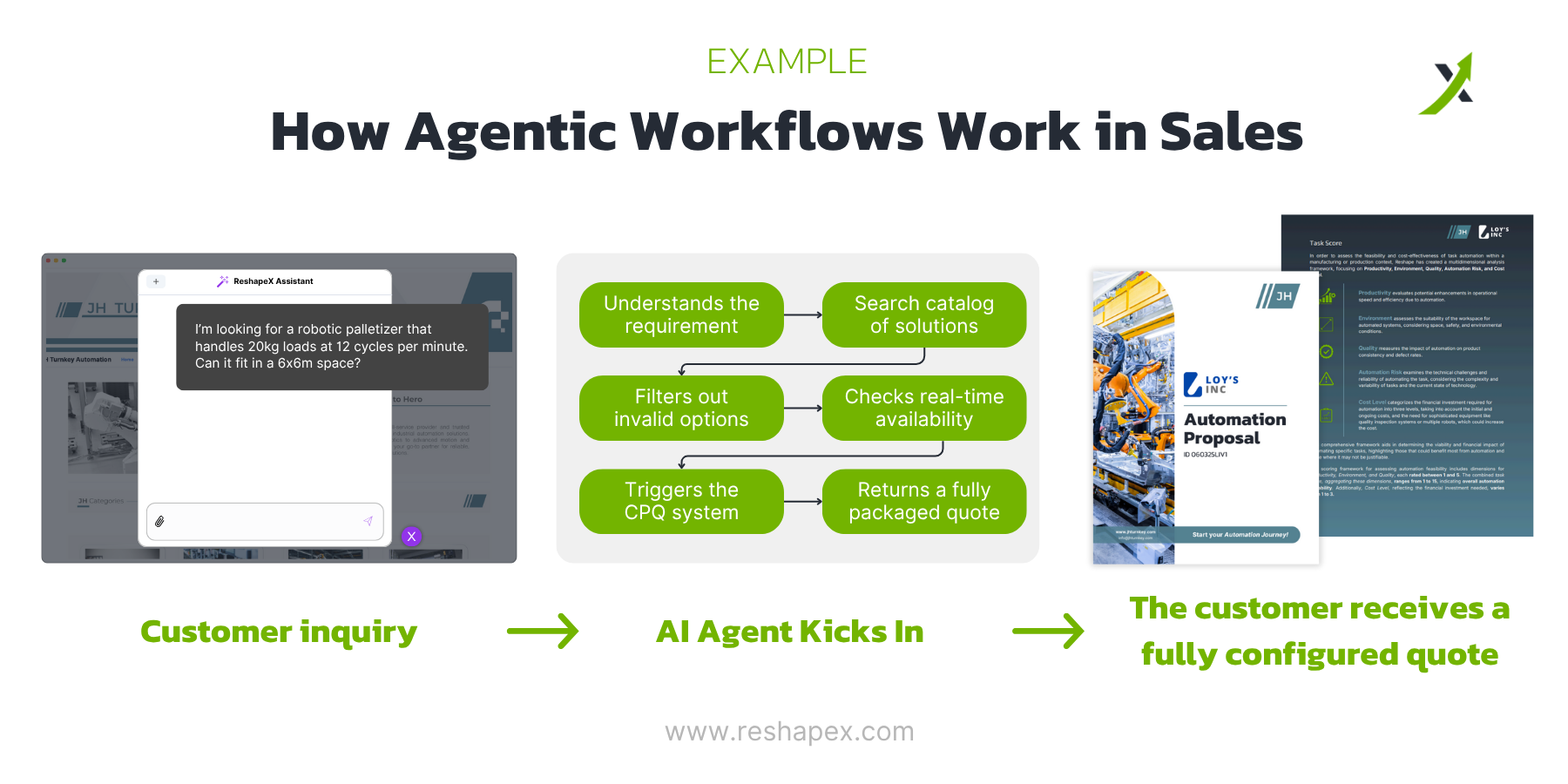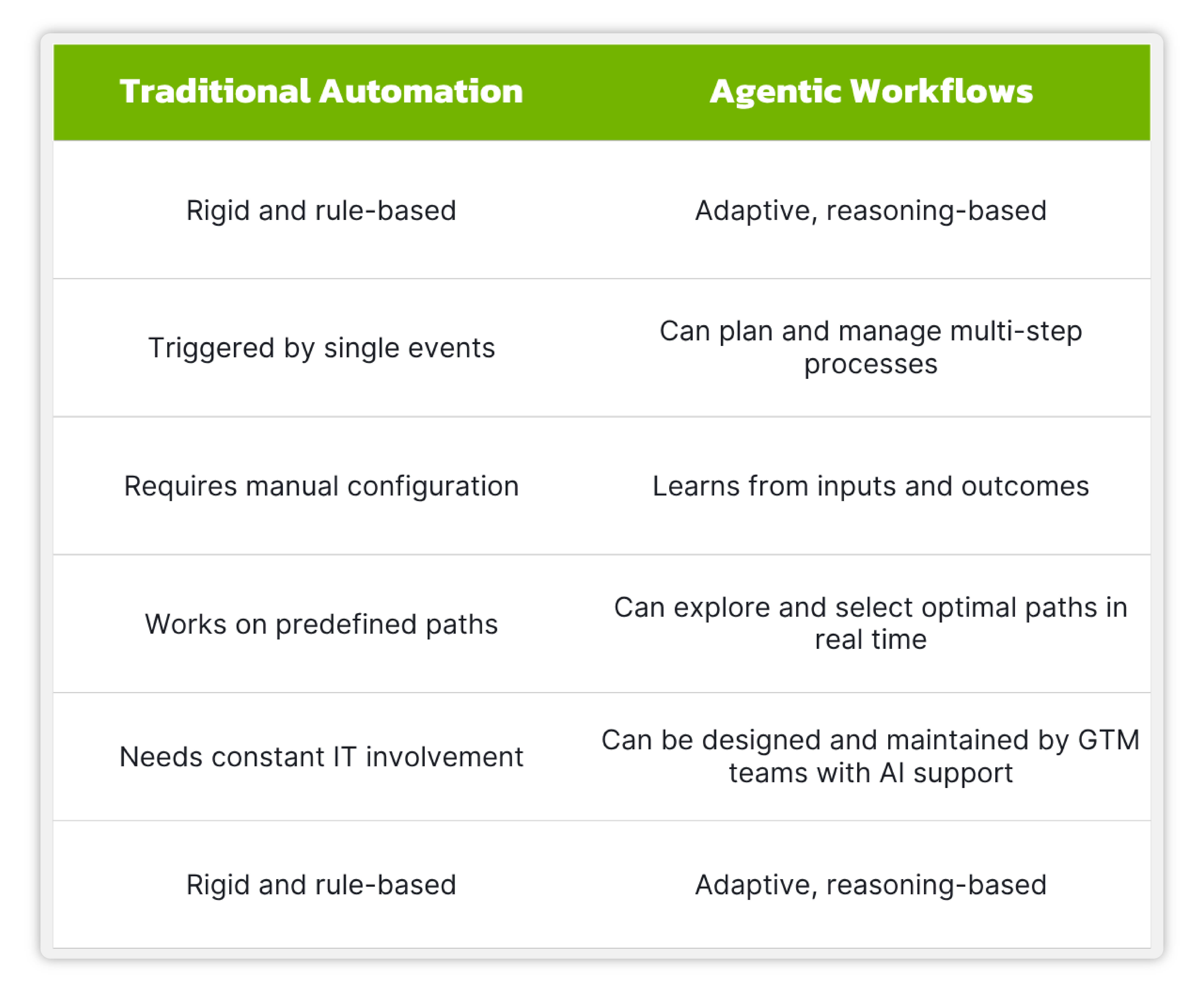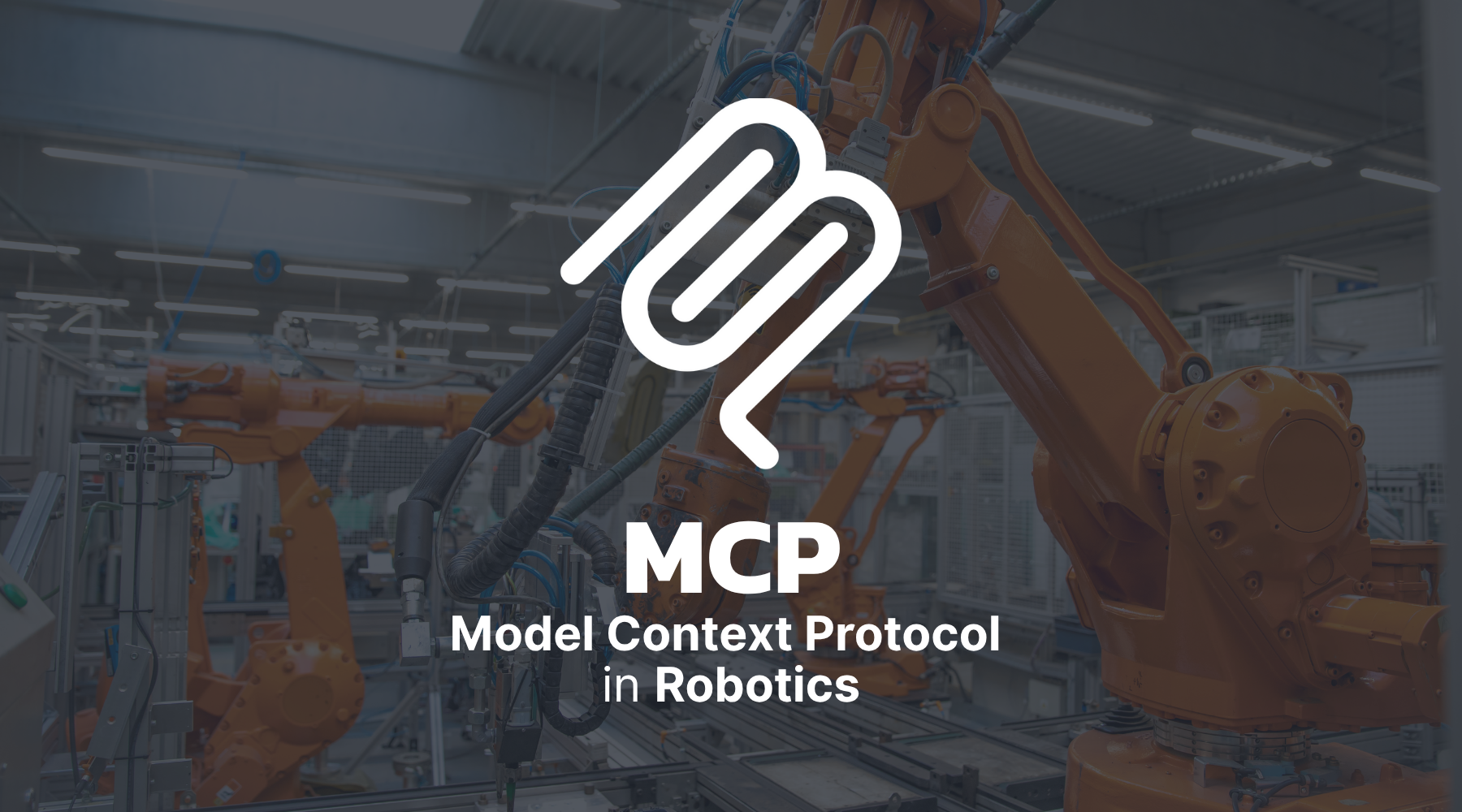In the automation world, engineering teams have long optimized production workflows. From robotic systems to predictive maintenance, factory floors have embraced efficiency.
But what about the sales floor?
While your machines are working smarter, your sales process may still run on PDFs, spreadsheets, email threads, and hard-earned tribal knowledge. The quoting cycle remains slow, inconsistent, and frustrating for everyone involved.
That’s where A come in.
AI workflows equip LLMs (Large Language Models) with software tools and business logic to run intelligent, multi-step sales processes. They reduce friction, speed up quoting, and help teams sell complex products at scale.
If you’re an OEM, distributor, or system integrator selling industrial automation equipment, this blog is your field guide to:
- What AI workflows are
- How they work in sales and operations
- Where they deliver the most value
- How to implement them without starting from scratch
Let’s get into it.
What Are AI Workflows?
Most likely you have already used or at least heard of ChatGPT. It uses LLMs (Large Language Models) which are AI models trained on massive datasets to understand and generate human-like language. These models can process and synthesize information at a scale far beyond traditional automation. However, in many cases, their interface is just a text box. So how do we make these powerful LLMs useful in automating tedious, complex tasks?
Enter AI workflows. AI workflows refer to business processes executed by LLMs when given access to specific tools, e.g. tools to write emails or to autocomplete quotes. When software entities can autonomously plan, reason, act, and adapt based on goals, data, and real-time inputs, we call them AI agents. They’re proactive, not reactive. And in the context of industrial sales, that’s a game-changer.

These AI workflows can:
- Interpret complex inputs: They don’t just react to simple commands. AI agents can digest unstructured requests like "Quote a 28-pack/min line for mixed 12oz and 16oz bottles using only Kinetix 5700 drives, IP69K components, Portuguese HMI, and no vision in a washdown area" and extract specs, constraints, and intent. Whether it comes via form fill, email, or voice note, they turn ambiguous language into structured action.
- Make decisions based on rules, context, and real-time data: Instead of relying on static rules alone, AI agentic workflows consider current inventory, product compatibility, customer history, and even pricing conditions. They simulate the judgment of an experienced sales engineer at scale.
- Take actions across systems: AI agents are not confined to one tool. They can move data and trigger actions across your CPQ, CRM, ERP, and support platforms. For example, an AI agent can configure a solution, generate a quote, update the CRM opportunity stage, and log a service ticket, all in one motion.
- Learn from past activity to optimize future responses: With every interaction, AI workflows get smarter. They learn which configurations get approved, which quotes convert, and where bottlenecks occur. Over time, they refine their responses to increase win rates and reduce friction.
They function like smart assistants that can own entire business processes, from the first customer inquiry to a validated, configured quote.
Unlike simple automation scripts or chatbots, AI workflows and agents are designed to:
- Handle multi-step logic chains
- Adapt to unexpected scenarios
- Maintain context across a conversation or sales process
Think of it this way: while traditional workflows involve predefined steps and rules, AI workflows are dynamic and adaptive. They can process incomplete information, fill in gaps, and make context-aware decisions in real time. They serve as glue between the dozens of software tools that are now part of your day to day operations. This makes them perfect for complex sales environments where every deal is different, products are highly configurable, and requirements change on the fly.
With AI workflows and agents, companies can automate entire sales processes that traditionally required manual intervention. Imagine an AI agent that can review a customer’s request, check for compliance with product rules, consult operational data for real-time availability or pricing, prepare a proposal, and present a configuration. This configuration can then be reviewed by a sales rep for approval or adjustment.
This not only speeds up the process but also reduces errors, ensures consistency, and frees up sales reps to focus on relationship-building and strategic activities. In essence, AI workflows are the bridge between advanced machine learning capabilities and practical, scalable business impact.
The Evolution of Sales Automation
Before we dive deeper into agentic workflows, it’s important to understand how we got here. Sales automation has been evolving steadily, though unevenly, for decades.
In the early 2000s, sales automation primarily meant CRM adoption:
- Logging activities
- Tracking deals
- Setting reminders
By the 2010s, companies layered in email automation and digital marketing, often using static logic: “If a prospect clicks a link, send this email.”
While helpful, these systems didn’t touch the core complexity of technical sales, especially in industrial automation.
Then came CPQ tools, enabling more accurate quoting for configurable products. But many companies implemented them as isolated systems, still requiring manual inputs and handoffs.
Now, in the 2020s, the game has changed again. With the rise of:
- AI workflows and AI agents
- Conversational interfaces
- Real-time product data
- Low-code/no-code orchestration
We’ve entered a new era where automation isn’t just about tasks, but outcomes.
Agentic workflows represent this next evolution:
- Less about reminders and templates
- More about intelligent, autonomous systems that think and act on behalf of your sales team
This shift mirrors what's already happened in operations and logistics.
How Agentic Workflows Work in Sales
Let’s break this down with a simple example:

Step 1: Customer Inquiry
A customer visits your website and asks:
“I’m looking for a robotic palletizer that handles 20kg loads at 12 cycles per minute. Can it fit in a 6x6m space?”
Step 2: AI Agent Kicks In
Your AI sales assistant parses the inquiry and launches an agentic workflow:
- Understands the requirement (intent, specs, constraints)
- Searches your catalog of turnkey palletizers using logic and historical match data
- Filters out invalid options
- Checks real-time availability or pricing conditions via your ERP
- Triggers the CPQ system to generate a quote
- Returns a fully packaged quote (with specs, lead time, price), which a human can review for completeness and approve or modify with just a few clicks
Step 3: The customer receives a fully configured quote
No phone tag. No spreadsheet errors. No 3-day wait.
Now let’s consider a slightly different inquiry:
“I’m looking for a robotic palletizer that handles 100kg loads at 6 cycles per minute. Can it fit in a 3x4m space?”
These requirements present an engineering challenge. Here’s how the AI assistant handles it:
- Understands the requirement (intent, specs, constraints)
- Searches your catalog of turnkey palletizers using logic and historical match data. No turnkey solution matches.
- Refers to past proposals and identifies a similar one with a larger footprint (e.g., similar payload and cycle time but 10x10m space)
- Opens a ticket with engineering, linking to the previous similar proposal, logging the opportunity with the appropriate status in the CRM, and passing the baton to the human team for a custom proposal
- Drafts an email for a sales rep to initiate a conversation with the customer to clarify the flexibility of the requirements
This agentic workflow doesn’t just automate; it actively collaborates with humans, bringing together past knowledge, real-time data, and human judgment to deliver fast, high-quality, and context-aware sales responses.
Real Examples of Agentic Workflows
Here’s how agentic workflows can be applied across different scenarios in industrial sales:
1. Inbound Quote Requests → Real-Time Response
A customer submits a form with project specs. The AI agent:
- Validates the request
- Suggests 2–3 configurations
- Auto-generates a quote with CPQ software
- Sends it within minutes
2. Rep Enablement for Custom Configurations
A new sales rep enters project details into an AI-powered interface. The agent:
- Recommends compatible product options
- Flags integration issues
- Provides pricing and BOM
3. Channel Partner Support via Self-Serve
A channel partner uses a guided workflow to:
- Input specs
- Explore options
- Access pricing and documents
No hand-holding needed. Partners operate independently.
4. Factory Walk → Automation Assessment
A field engineer sends a voice note after a factory walk summarizing the visit. The AI agent:
- Extracts key requirements about the opportunity
- Compares them against known automation solutions
- Generates a preliminary automation assessment report
▶ Watch Example: From voice note to proposal: AI agent processes a factory walk
5. Customer Inquiry → Operational Data-Driven Sizing
A customer asks about sizing a conveyor for a unique load. The AI agent:
- Pulls historical data from deployments (like similar load weights and cycle times)
- Calculates expected performance in the customer’s context
- Provides a recommended design with real-time constraints (space, power, capacity)
CPQ Tools and Workflow Automation: The Building Blocks
To implement agentic workflows, you need two key foundations:
CPQ (Configure, Price, Quote) Software
CPQ tools:
- Enforce product logic
- Generate pricing based on real-time rules
- Produce detailed quotes with specs and BOMs
They reduce engineering involvement and bring speed and consistency to quoting.
Workflow Automation
Workflow automation tools:
- Orchestrate actions across CRM, CPQ, ERP, email, and chat
- Ensure data flows between systems automatically
- Trigger follow-up tasks, document generation, and approvals
Together, CPQ and workflow automation create a connected, scalable infrastructure.
AI workflows are the catalyst- they bring intelligence and adaptability to these processes, enabling systems to make decisions, learn from data, and respond dynamically to customer inputs. This combination doesn’t just speed up sales; it transforms it into a seamless, intelligent experience that scales with your business needs.
Where AI and Agentic Workflows Create Value
The beauty of AI workflows is how they map to everyday sales bottlenecks and remove them. Here’s where they deliver the most impact:
1. Quoting Automation
Sales teams often spend hours manually creating quotes or going back and forth with engineering. Agentic workflows:
- Pull customer needs from form inputs, chat, or emails
- Generate real-time configurations
- Feed validated options into a CPQ tool
- Return pricing and documents instantly
This creates a seamless quote-to-cash experience that’s fast, accurate, and scalable.
2. Product Discovery and Configuration
Agentic workflows can act as interactive guides, helping customers (or reps) navigate a complex product catalog and arrive at the best-fit solution.
Unlike simple filters or dropdowns, these workflows:
- Ask clarifying questions
- Explain tradeoffs
- Learn from previous interactions
- Dynamically adjust based on user behavior
The result? Faster discovery, fewer dead-end conversations, and more qualified buyers reaching your reps.
3. After-Sales Support and Issue Resolution
AI workflows don’t stop at the sale; they extend into after-sales support. When a customer asks, “Where is my product?” or “How can I fix this?”, the AI agent:
- Checks order status in real time through the ERP
- Provides shipment tracking or delivery updates
- Diagnoses common issues using product data and past resolutions
- Suggests troubleshooting steps or recommends replacement parts
- Escalates complex cases to the appropriate service team with context and history
This creates a responsive, proactive support experience that minimizes frustration and builds customer loyalty.
4. Distributor and Channel Partner Support
Imagine a partner in another region wants to quote a solution but doesn’t know the ins and outs of your latest product line.
With agentic workflows embedded in your B2B ecommerce platform, they can:
- Input the application specs
- Get guidance on configuration
- Generate a quote
- Access pricing based on their tier
Now they can operate independently without emails, calls, or delays. That’s true channel enablement.
5. Automating Boring and Tedious Data Collection
Keeping CRM records up to date can feel like busywork. AI workflows can automate data entry by:
- Converting voice notes from sales reps into structured CRM updates
- Automatically logging interactions and key deal updates
- Capturing follow-ups, contact details, and next steps directly from conversations
This ensures your CRM is always accurate and up to date without adding to your team’s workload.
Why This Matters in Industrial Sales
Industrial automation sales is uniquely suited for agentic workflows because:
- Products are complex and highly configurable
- Sales cycles are technical and time-sensitive
- Internal resources (like application engineers) are stretched thin
- Customers expect instant, digital-first experiences
If your team is still quoting with spreadsheets, PDFs, or tribal knowledge, you’re bottlenecking your ability to scale.
AI workflows remove that friction and replace it with repeatable, intelligent sales processes.
Traditional Automation vs. Agentic Workflows
Choosing the right configurator can make or break your digital sales strategy. Here’s what to look for:

What Tools Support AI Workflows?
AI workflows aren’t theoretical; they’re already in play inside some of the most forward-thinking industrial sales teams.
Several emerging tools now combine:
- AI agents trained on product logic
- Embedded CPQ workflows
- Smart forms and conversational interfaces
- Real-time quote generation
- Partner-ready portals
Some platforms (like ReshapeX) offer this infrastructure out of the box, tailored specifically for industrial automation sales.
The result? You reduce engineering bottlenecks, improve rep ramp-up, and let customers or partners move from inquiry to quote without waiting on anyone
AI workflows are more than a trend. They’re the new foundation for scalable, intelligent sales in complex industries.
To recap:
- They automate reasoning-based processes, not just tasks
- They reduce manual load on sales and engineering teams
- They enable faster, smarter, self-serve sales experiences
- They unlock consistent quoting and scalable infrastructure
Some companies are already there. They’re quoting in minutes, not days. Letting partners self-serve. Onboarding reps in record time.







.png)